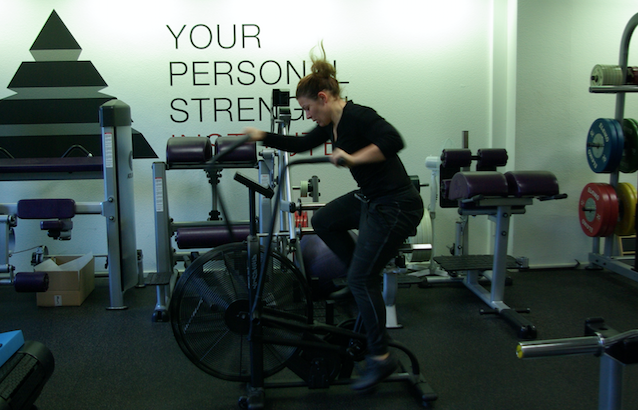The Air Bike is particularly popular in the mixed martial arts – MMA for short – area as a supplement primarily for building fitness. Condition is defined as follows:
"Condition is the ability to repeat a given effort with minimal fatigue"
In an MMA fight, a round lasts five minutes. A full-length fight usually lasts two rounds for amateurs, three rounds for professionals and five rounds for championship fights and main events. Since only two athletes face each other in the cage, the stress density of an MMA fight is very high. Classic Stamina is less critical, as it rarely takes a specific action longer than 10 seconds. However, physical condition is very important, as many individual actions such as punches, kicks, takedowns, clinches and changes of position are performed constantly and mostly alternately. Especially in wrestling, clinch and ground fighting, physical condition and, above all, lactate tolerance play a major role. The air bike, among other things, is very well suited for non-specific training of condition and lactate tolerance.
Why use the Air Bike in MMA sport?
As discussed in detail in my article Fitness is Specific , training specifically for a sport is critical to getting better at it. That means an MMA fighter to get better and fitter for MMA, MMA sparring is the best solution. Sparring in MMA is sport-specific fitness training. Training on an air bike is therefore non-sport-specific fitness training.
The big advantage of sparring is the proximity to the sport, but the disadvantage is a limited volume of sparring that is possible per week due to fatigue and risk of injury. In comparison, the Air Bike is much less specific, but entails a much lower security risk. Giving out or receiving punches, kicks, throws and levers is much less safe than sitting on a bike and kicking against air resistance. The optimal combination of both forms of training will bring the most and most lasting success. However, MMA training always has priority. Just because someone is in good physical condition and does well on the air bike doesn't win them a fight. If a fighter who is technically well trained, however, depending on the fighting style and strategy, can decide a fight for themselves. And of course prevent a disadvantage compared to his opponent due to lack of condition.
Training on the air bike is an excellent complement to MMA training, especially at a performance level that trains more than 6 times a week. Or for a fighter who wants to get in shape for a fight as quickly as possible.
How do I plan a training session on the Air Bike?
One of the most critical principles of successful program design is:
"Any training program is only as effective as its assessment and as successful as its accounting."
That means determining exactly where the deficits lie and therefore what they need to train to get better is crucial for an athlete's progress. And then measure how much he's improving. Both are easily possible in terms of condition and lactate tolerance on the air bike.
I developed the following challenge for the fighters from Peter Sobotta's Planet Eater MMA Gym, which determines the endurance and condition of a fighter's explosive power and lactate tolerance. And at the same time it is a great challenge mentally and physically:
The 40/4 Air Bike Challenge looks like this:
40 seconds allout - 4 minute rest - repeat 4 times
From a practical point of view it is crucial:
The goal is to pedal as many watts as possible in each interval. And as little fatigue as possible from interval to interval.
From a technical point of view of training control, the following is crucial:
After each interval, record the average watt count. The average wattage of the first 40 seconds allout and the reduction of the average wattage in the other four intervals are of interest for training control.
The average watts of the first interval is a good indicator of a fighter's explosive power, explosive power endurance and lactate tolerance. The amount of reduction over the five intervals is an indicator of his condition. The smaller the reduction, the better his condition and thus the less decisively more training time to invest in fitness training.
In the YPSI, I use different percentages of the first interval in relation to the maximum squat power as well as the reduction in average watts from the first to the fifth interval.
Based on the result, the focus in training is then placed more on building maximum and explosive strength or building up condition.
Testing the 40/4 Air Bike Challenge is the next step for any reader of the article looking for a challenge. Suffice to say, the challenge looks a lot easier on screen than it actually is.
Good luck training for MMA with the Air Bike!
More information on training planning for interval training and the air bike is also available at the YPSI Interval Training Program Design and Periodization Seminar in May 2018.
Picture: Planet Eater MMA fighter Nicole Stoll on the Air Bike at the YPSI.

